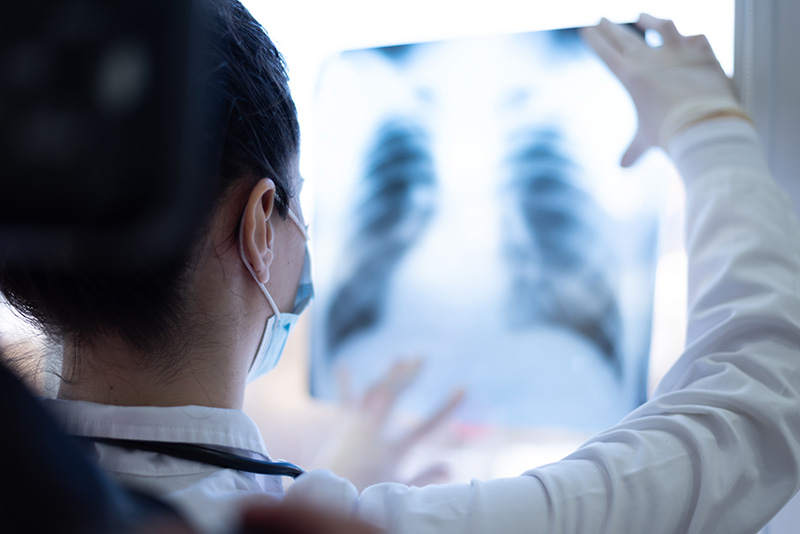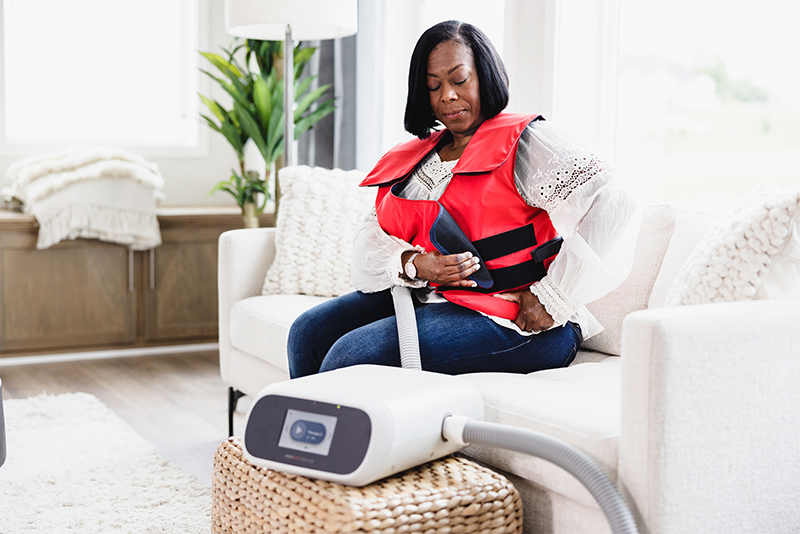
Do you have a persistent cough? Are you often short of breath or feel tightness in your chest? These symptoms are more than a nuisance; they may be an early sign of a serious lung condition.
If you’re experiencing a decreased quality of life due to frequent lung issues, consulting a pulmonary doctor is a practical next step to protecting your respiratory health and wellness.
What Is a Pulmonary Doctor?
A pulmonary doctor, also known as a pulmonologist or lung specialist, diagnoses and prescribes treatment for conditions related to the lungs and respiratory system.
Conditions may include common ailments like asthma and bronchitis to more severe illnesses, such as chronic obstructive pulmonary disease (COPD), bronchiectasis, or lung cancer.
Can I See My Doctor for a Lung Issue?
While a regular clinician may have a general understanding of lung conditions, a pulmonologist has specialized training and experience. Therefore, they are best equipped to conduct tests and procedures that other clinicians may not be trained to perform, such as a bronchoscopy.¹
Additionally, pulmonologists have a deeper understanding of the complex physiology of the lungs and respiratory system, allowing them to provide targeted treatments and therapies to help improve quality of life.
In fact, your doctor will likely recommend (or refer) you to a lung specialist if you are experiencing respiratory symptoms or have been diagnosed with a chronic lung condition.
Pulmonologists can collaborate with your healthcare team to ensure you receive the most comprehensive and effective pulmonary care possible.
How Lung Specialists Prioritize Your Lung Health
The respiratory system is vital in delivering oxygen to your body and removing carbon dioxide. But it does much more than that. Our respiratory system has a natural way of removing mucus buildup to prevent lung infections.
The cilia, tiny hair-like structures lining the respiratory tract, move together in a wave-like motion to push mucus upward and out of the lungs.
This process helps to protect our lungs from harmful particles and microorganisms that can cause infections. Therefore, it’s important to keep our respiratory system healthy and manage any symptoms that may prevent it from doing its essential functions.
When your lungs or airways are compromised, it can lead to serious health issues. Therefore, consulting a pulmonary doctor is essential for several reasons:



- Accurate Diagnosis: A pulmonologist has specialized knowledge and training in diagnosing and treating respiratory conditions. They can accurately assess your symptoms, perform necessary tests, and provide a comprehensive treatment plan tailored to your needs.
- Early Detection: Early detection typically results in less invasive treatment of a condition and can prevent further complications. Many lung diseases progress slowly, and symptoms may only be noticeable once the condition has advanced. As a result, regular consultations with a pulmonologist can help identify any underlying issues before they worsen.
- Support & Treatment: A pulmonary doctor can offer ongoing support and management for chronic respiratory conditions, helping to improve your quality of life and minimize the impact of your symptoms.
5 Reasons to Visit a Lung Specialist
To answer whether you should consult a pulmonary doctor, let’s first explore some common signs of pulmonary issues that would prompt an initial visit.
Chronic Cough
A persistent cough is one of the most common symptoms that may warrant a consultation with a pulmonary doctor. While occasional coughing is normal and often results from a respiratory infection, a persistent cough lasting several weeks or longer could indicate an underlying problem.²
Chest Pain & Tightness
While various factors can cause chest pain, it may be a symptom of certain pulmonary conditions:
- Pleurisy is an inflammation of the lining around the lungs, causing sharp chest pain that worsens with deep breathing or coughing.³
- Pulmonary hypertension, characterized by high blood pressure in the lungs’ arteries, can also lead to chest pain or discomfort.4
- Bronchiectasis, an irreversible chronic lung condition, causes inflammation and irritation in the airways, leading to discomfort and chest pain.5
- Asthma can also cause inflammation and a narrowing of the airways, leading to difficulty breathing and a feeling of tightness or pressure in the chest.6
These are just a few examples of lung conditions that may cause chest tightness. Therefore, if you experience this or other symptoms mentioned on this list, consulting a pulmonary doctor is crucial for proper evaluation and management.
Shortness of Breath
Shortness of breath, also known as dyspnea, is another common symptom that can occur for various reasons. Therefore, it’s important to differentiate between normal shortness of breath during physical exertion vs. persistent or unexplained shortness of breath. If you find yourself feeling breathless even at rest or with minimal exertion, it could be a sign of an underlying pulmonary condition, such as:
- Asthma
- COPD
- Bronchiectasis
- Pulmonary Fibrosis
Fatigue
Fatigue may result from any of the following:
- Lack of sleep
- Stress
- Certain medical conditions7
However, if you consistently feel tired or lack energy, it may indicate an underlying respiratory problem. Conditions such as COPD and bronchiectasis, for example, can cause fatigue due to increased breathing effort.
Repeated Respiratory Infections
Repeated lung infections may indicate that your lungs are not functioning properly, leaving them more susceptible to bacterial infections.
If your lungs cannot clear mucus on their own, the mucus will accumulate (i.e., build up) over time, resulting in infections that may require hospitalization.
Each cycle of infection can cause permanent damage to your lungs, leading to further complications.
How do Pulmonary Doctors Diagnose Lung Conditions?
Lung specialists will perform various diagnostic tests to evaluate your respiratory health accurately.
These tests may include:
- Pulmonary Function Tests: These tests measure your lung capacity and how well your lungs perform. They can help diagnose asthma, COPD, and pulmonary fibrosis.
- Chest X-Ray: A chest X-ray can provide a detailed image of your lungs and help detect abnormalities or signs of infection.
- Computed Tomography (CT) Scan: A CT scan provides more detailed images of your lungs and can help identify conditions such as lung cancer, pulmonary embolism, or interstitial lung disease.
- High-Resolution CT (HRCT) Scan: This medical imaging technique uses X-rays to produce detailed images of internal structures in the body. The images produced then create 3D models to help show the size, shape, and position of your lungs.
- Bronchoscopy: This procedure involves inserting a thin, flexible tube with a camera into your airways to visualize any abnormalities or collect samples for further testing.
- Blood Tests: Blood tests can help assess your oxygen levels, check for infection, or detect specific markers associated with certain respiratory conditions.8
These diagnostic tests, a thorough physical examination, and a medical history review, allow the pulmonary doctor to make an accurate diagnosis and develop a personalized treatment plan.
Types of Treatments Pulmonary Doctors Prescribe
Treatment options can vary depending on the specific diagnosis and severity. Your pulmonologist will develop a personalized treatment plan tailored to your needs, which may include one or a combination of the following:
Medications
Depending on the underlying condition, medications such as bronchodilators, corticosteroids, or antibiotics may be prescribed to alleviate symptoms and manage the condition.
Lifestyle Modifications
Making certain lifestyle changes, such as quitting smoking, maintaining a healthy weight, and avoiding environmental triggers, can help manage respiratory conditions and improve lung health.
 High-Frequency Chest Wall Oscillation (HFCWO) Therapy
High-Frequency Chest Wall Oscillation (HFCWO) Therapy
SmartVest’s HFCWO therapy involves using a respiratory vest that you wear to create high-frequency vibrations in the chest. These vibrations help to loosen and clear mucus blocking the airways, to make breathing easier and helps to reduce the risk of lung infections.9 HFCWO therapy may be helpful for individuals with conditions such as bronchiectasis, cystic fibrosis, or COPD with an overlap of bronchiectasis.
Pulmonary Rehabilitation
Pulmonary rehabilitation programs can help improve lung function, increase exercise tolerance, and provide education and support for managing respiratory conditions.10
Surgery
In some cases, surgery may be necessary to treat certain pulmonary conditions, such as lung cancer or severe COPD. Surgical options may include lung transplant or tracheostomy.11
Your pulmonary doctor will determine the specific treatment plan based on your individual needs and the underlying condition.
Take Charge of Your Pulmonary Care
By recognizing the key signs and symptoms of pulmonary issues, you can seek medical advice promptly, allowing for early diagnosis and appropriate treatment.
If you experience persistent coughing, shortness of breath, chest pain, or any other concerning symptoms, consulting a pulmonary doctor can help.
Watch Our Pulmonologist Series
Before you go, don’t miss our video series, “Ask a Pulmonologist,” which highlights the expertise of Dr. Frederic Seifer, a renowned specialist in lung health.
In this series, you can learn about bronchiectasis and how it can be linked to other serious conditions like COPD. Additionally, Dr. Seifer shares valuable insights on the benefits of HFCWO therapy for the lifetime management of this condition. He also provides tips on how to talk to your doctor and get a proper diagnosis to ensure you receive the best possible treatment to manage your symptoms.
If shortness of breath, frequent cough, or chest pain is getting in the way of you enjoying life’s moments, learn how SmartVest could help. Request an informational packet to share with your doctor.
Need help finding a pulmonologist in your area or have questions about how SmartVest could help? Call our Respiratory Therapists at 1.855.528.5690.
Resources
[1] John Hopkins Medicine. “Thoracentesis.” Retrieved from https://www.hopkinsmedicine.org/health/treatment-tests-and-therapies/thoracentesis
[2] Cleveland Clinic. “Chronic Cough.” Retrieved from https://my.clevelandclinic.org/health/diseases/15048-chronic-cough-overview
[3] Cleveland Clinic. “Pleurisy.” Retrieved from https://my.clevelandclinic.org/health/diseases/21172-pleurisy
[4] National Heart, Lung, and Blood Institute. “Pulmonary Hypertension.” Retrieved from https://www.nhlbi.nih.gov/health/pulmonary-hypertension
[5] American Lung Association. “Bronchiectasis Symptoms and Diagnosis.” Retrieved from https://www.lung.org/lung-health-diseases/lung-disease-lookup/bronchiectasis/symptoms-diagnosis
[6] Medical News Today. “Is Chest Pain a Symptom of Asthma?” Retrieved from https://www.medicalnewstoday.com/articles/322071#does-asthma-cause-chest-pain
[7] Cleveland Clinic. “Fatigue.” Retrieved from https://my.clevelandclinic.org/health/symptoms/21206-fatigue
[8] National Heart, Lung and Blood Institute. “Tests for Lung Disease.” Retrieved from https://www.nhlbi.nih.gov/health/lung-tests
[9] Sievert C et al. Respiratory Therapy, Vol. 11 No 4, 34-38, 2016.
[10] National Heart, Lung, and Blood Institute. “Pulmonary Rehabilitation.” Retrieved from https://www.nhlbi.nih.gov/health/pulmonary-rehabilitation
[11] National Heart, Lung, and Blood Institute. “Lung Disease Treatments.” Retrieved from https://www.nhlbi.nih.gov/health/lung-treatments






